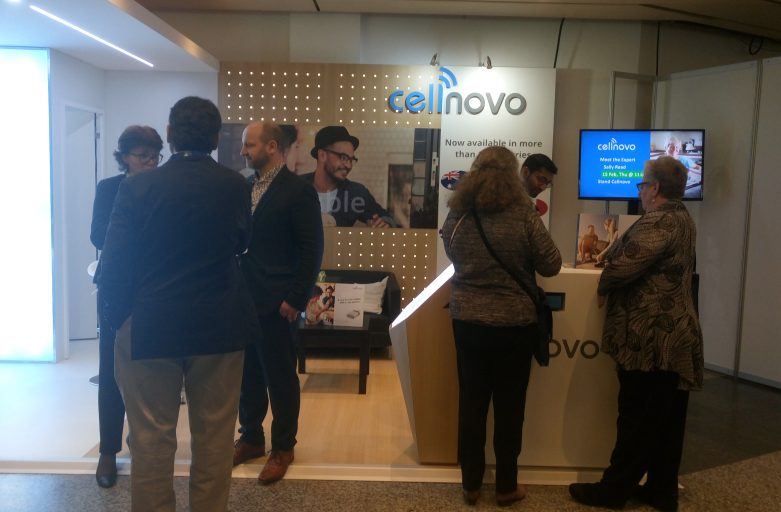Advanced Technologies and Treatments for Diabetes 2019 – Berlin: Conference Report
As ever, the ATTD annual conference was a masterclass of organisation and content. Three days of lively interaction and almost too many sessions to attend, meant that delegates left for home with full brains and many, many bags full of papers, gizmos and chocolates…
While I am not a diabetes nurse specialist, attending the ATTD conferences gives me valuable insights into the amazing research being undertaken to make the life of PWD easier. I must thank Kenes, the organisers, for generously giving me a press delegate badge, which allowed access to all areas (mostly!). Here I present some of my thoughts and take-home messages from this fabulous event.
Take-away messages
- Medtronic – 670g launched in Europe; aim to have a personalised closed-loop system that will keep time-in-range >85%, and adapt to behaviour and physiology within next two years. CareLink system promoted
- Dexcom – Reporting 670g/SmartGuard suspend-before-low studies, and giving a clear message that continuous glucose monitoring is effective at reducing glycaemic variation. G6 CGM promoted. Latter can be liked to Siri and Apple watch
- Sanofi – Gla-300 improves glycaemic control by 30-40% when used with CGM and CSII; 2nd generation basal insulins are better and will be better with technology
- Time in Range – More effective metric for reflecting glycaemic variability than HbA1c
- Harvard Closed-Loop System – Working towards and ecosystem; human-centric design, towards wearable devices. Currently trialling use of smartphone-connected AP rather than having separate handset
- The Accu-Chek Solo micro-pump – Comprised of an inserter, pump holder, 6mm or 9mm cannula, a durable component, a reservoir and a controller. Reservoir holds up to 200 units of insulin, and the controller allows full pump control, bolus (extended and dual), temporary basal rates and SMBG. It is also removable during use
- Tandem – T:slim X2 insulin pump with Basal-IQ predictive low-glucose suspend (PLGS)
- Commence CGM immediately post-diagnosis
- The portable diabetic retinopathy camera was the star of the exhibition – never have so many eyes been photographed in such a short period of time!
1. Plenary Sessions
Decision Support Systems (DSS)
Do we need DSS? – eGlycemic Management System (eGMS) (Glytec). Such systems can help improve quality of life and achieve better clinical outcomes. The eGMS dosing algorithms for intravenous, subcutaneous, and pediatric insulin are standardised, thereby facilitating a decrease in rates of hypoglycaemia and hyperglycaemia by analyzing the data and providing efficacious real-time dosing recommendations. Can be used in hospital and home settings. 2018 study demonstrated 95% of pts within target (with associated reduction in hypos), a saving of 72 minutes per nurse, and a decrease in length of stay. This amounted to a total saving of $9.7m
ATTD Yearbook
This session outlined the articles contained in the 2018 ATTD yearbook, with comment from the ATTD selection committee.
2. Parallel Sessions
Closed-loop systems: where are we now?
Medtronic 670g hybrid closed-loop in USA – Delivers auto-basal every five minutes in accordance with a number of parameters. It has improved time in range; however, needs to be calibrated 3-4 times per day , carbohydrate intake has to be entered and it does not share information via Bluetooth
Cambridge closed-loop system – In a 12-week RCT comprising children, adolescents and adults, over 12 weeks using either closed-loop or SAP, time to target was improved by 11%, mean glucose reduced by 0.8% to 3.9mmol/dl, HbA1c reduced by 0.4% (baseline 8.3%) and time in range improved. In a three-week RCT (KidsAP), using U100 or U200 aspart insulin in the closed-loop system, the study group achieved 70% time in target. Another study of the system vs standard treatment over 7 days resulted in a 20% increase in time in range for the study group
Harvard closed–loop system – 12-week study, 24h ambulatory AP; 88% of time spent in range, 1% <70mmol/dl. New development – working towards and ecosystem; human-centric design, towards wearable devices. Currently trialling:
-
- use of smartphone-connected AP rather than having separate handset
- use in pregnancy
- other biomarkers and how they may enhance the AP system
University of Virginia closed-loop – Project NIGHTINGALE; international study using InControl with a variety of CGM and pumps or Tandem, Control-IQ, and Dexcom CGM (includes auto insulin correct, a dedicated hypo safety system and intensified control overnight) to explore time spent <70mmol/dl during early evening/night closed-loop control. Of 60 who have completed study, 33 had the mobile configuration (inControl) and 23 had embedded control (Control-IQ). Results from evening/overnight closed-loop control showed that both systems improved time in range and decreased the number of hypo episodes. Both had good connectivity. There was an overall preference for the use of the system for 24 hours rather than just overnight
Psychological interventions to increase the use of technology in T1D pts
Adherence to insulin pump behaviours in young children – Children often administering insulin without full information (e.g. carb count or blood glucose measurement). Review of information showed that: 42% of parents are not entering child’s BG, but administering insulin; many parents calculate their adolescent’s dose, and that parents adherence to pump advice relate to their child’s glycaemic outcomes. However, feeding back pump and CGM information to parents helps them correct behaviours and identify why they are reacting to BG readings rather than implementing behaviours to prevent. The REDCHIP programme has demonstrated a decrease in fear of hypo, parenting stress, diabetes stress and child HbA1c
Psychosocial aspects and diabetes technology – The burden of treatment can often outweigh the benefit, especially in diabetes. Challenge to ‘onboard’ PWD. A number of educational interventions can help to manage diabetes distress etc, and improve ‘on-boarding’ with regimens, thereby reducing HbA1c. Also have to consider how to deal with the emotions PWD feel when they have ‘adhered’ to regimen, yet targets are not being met. In summary, effective ‘on-boarding’ can be achieved by; an effective assessment of user needs beyond glycaemic control; personalising device settings such as alarms and individual targets; considering the barrier to and benefits of pump use, balancing technology with psychosocial needs
Preventing poor psychosocial and glycaemic outcomes in teens – Teens are emotional decision makers; make technology easier for them to manage, make it wearable and comfortable. May have to consider ‘buy-in’ for only short periods, then review. Manage expectations
3. Industry Symposia and Industry Parallel Sessions
Sanofi: Viewing the diabetes spectrum through a new lens
Drivers of unmet needs. Fear of hypo from both clinicians and patients often prevents starting of insulin (in Type 2) and leads T1D to adjust their own dosage (especially after a hypo).
Dynamic titration, whereby insulin is titrated within the first 8-12 weeks is successful in 70-80% of PWD. An early glycaemic response is predictive of long-term control; a hypo during the first 12 weeks of insulin therapy indicates a six-times greater likelihood of long-term hypo risk. BRIGHT Study: Gla-300 vs Deg in T2 insulin naive pts or those with uncontrolled glucose. Both insulins had similar effect in terms of reducing HbA1c. Majority of changes occurred in first three months, with little change after (predictor of long-term control). Incidence of hypo throughout the day was numerically lower for Gla-300.
Improving outcomes in T1D – Hypos affect quality of life, contribute to lost productivity, increased healthcare costs, and are linked to cardiovascular problems. Minimising glycaemic variability (GV) is therefore critical; however, GV within day and between day makes insulin dose titration difficult, as do individual requirements, variable delivery and variable pharmcokinetics.
Gla-300 improves glycaemic control by 30-40% when used with CGM and CSII; 2nd generation basal insulins are better and will be better with technology
Time in range and GV – HbA1c metric is easy, cheap and predictive of vascular problems; however, the ‘ideal’ level varies between countries and physicians, it only represents an average and doesn’t reflect GV. Pts understand % time in hypo range, % time in hyper range and % time in target, and GV.
– Time in range can correlate to/be indicative of potential complications such as retinopathy; a 5-10% increase in time in range (commonly 70-180[in some cases 140]mmol/dl) is a benefit
– GV is a determinant for risk of hyper & hypo episodes. It reflects amplitude and time, and glucose excursions. It is measured by the coefficient of variance (above 36% represents and increased risk of hypo) and low blood glucose index. Recent study demonstrated that using Gla-300 vs Gla-100 resulted in fewer nocturnal hypos and a smoother 24h GV profile.
Medtronic: Automating insulin delivery to maximise glycaemic control with SmartGuard Technology
Technology can help reduce sever hypo. Hybrid closed-loop 670g now available in Europe. Has auto-basal function (changes very few minutes at different rates). This counteracts Dawn phenomenon and frequency of hypo vs those who programme basal rate ahead of time.
– Aim that in next 2 years will have a personalised closed-loop system that will keep time-in-range >85%, and will adapt to behaviour and physiology.
SMILE Study – Use of MiniMed 640g with SmartGuard suspend-before-low compared with CSII (MiniMed 640g without CGM) in high-risk (hypo unaware) patients. Six-month study. Results showed 73% reduction in number of hypo events, 79% reduction in time spent in hypo and a significant reduction in patient reported fear of hypo. Concluded that suspend-before-low feature provides additional benefits to CSII users
MiniMed 670g: Increasing time-in-range – Study of 670g with SmartGuard auto mode and 670g manual mode. HbA1c dropped to 6.9% from 7.4% in study group. Reduced glycaemic variation seen, particularly in the early hours. Time-in-range (increased by 10%) was similar to other pivotal studies.
Next steps in closing the loop – CareLink – software that enables you and the healthcare provider to download and see historical data that has been collected in the form of graphs, charts and reports
Dexcom: Fit for the Future – Merging Technology and Digital Solutions for Integrated Diabetes Management
Progress towards closed-loop therapy using Dexcom CGM. The Control-IQ, Dexcom and Tandem Control algorithm gives an auto-correction bolus, has automatic basal-rate modulation and takes into account insulin-on-board and other factors to prevent hypo.
2015-2018 Steady State AP (artificial pancreas) study: Protocols developed for mobile closed-loop control. 125 participants. Time-in-range (<70mmol/dl) improved, particularly overnight
CGM-Based decision support for multiple daily injection pts using Dexcom CGM – Less than 50% of T1D pts reach their glycaemic target. In addition, only a small fraction of data generation by devices is used; however, treatment decisions are multifactorial and their impact changes daily. Breton et al (2018); pilot of patient-facing decision support system, (automated insulin titration, bolus calculation with glycaemic prediction and insulin-on-board, carbohydrate treatment advice and hypo alerts). The DSS significantly reduced glycaemic variation, while maintaining glycaemic control by reducing hypoglycemia exposure.
Technology innovation – Dexcom G6: No finger-pricking or calibration required, urgent ‘low-soon’ alert, custom alert schedules, 10-day wear sensor, indicated for treatment decision/dosing, and MARD 9%. Soon to have improved data share facility (10 people), Dexcom CLARITY (more information on glucose trends), compatibility with Apple watch and Siri (can ask latter for glucose reading), and reminders for sensor expiry. Will be compatible with a number of insulin delivery devices (iCGM)
Roche: Integrated, personalised diabetes management. Connecting the dots
Big data – the future of diabetes management – Healthcare data such as electronic medical records, wearable data and genetic data accounts for 80% 0f internet traffic. Unfortunately, it is complex, presented in various formats, and is unstructured, inconsistent and not commoditised. Such data can determine; triggers of high management costs, preventative measures, admission/readmission reduction and contribute towards decision support tools and therapeutic algorithms.
– Tools include: prevention, diagnostics, treatment and monitoring (e.g ‘patientslikeme’, Glooko, etc) MySugr has demonstrated improved glycaemic management in terms of HbA1c and time in range. BlueStar, a patient coaching app and helped reduce both hospital visits by 58% and HbA1c.
– Challenges to the introduction of such tools include; payer reimbursement, reach (availability), changing physician behaviour (from pills to behavioural management/decision support system advice). However, funding bodies are demanding
better outcomes in care, as are PWD, so adjunctive tools are being adopted where possible
– Predictive analytics: 1. define desired clinical outcome 2. Choose correct technology features (real-time personalised content and features) 3. Understand full-care ecosystem (connectedness to total care ecosystem) 4. Establish new capabilities and ways of working (holistic operating model)
Drugs, data and technology: how to overcome clinical inertia – Despite available guidelines for management, inertia remains an issue; doctors and PWD reluctant to change treatment regimen despite evidence that alternatives may be better in terms of outcomes. Insulin titration is often delayed even if BG indicates a need to change.
– PROValue study – integrated, personalised diabetes management programme (T2D with insulin) which included lifestyle interventions and pharmaceutical adaptation. HbA1c was lowered by 0.5% as a result of earlier, more frequent changes to insulin dosing
Insertable CGM technology – 6-month sensor (Eversense) wear time – 27% of CGM users discontinue during 1st year due to trouble inserting the sensor, discomfort, dislocation of sensor during activity, privacy, skin reaction, or payer issues. The Eversense is implanted sub-dermally and can be left in-situ for up to 180 days. The PRECISE study demonstrated that % time in target ranged from 53% to 69% across countries studied.
Taking CSII to the next level; new pump solutions – Micro-pumps are the next big thing. Current patch pumps, although proven to reduce HbA1c and hypo frequency, particularly in those at highest risk are thought to be wasteful (environmental impact and waste of insulin), increase the risk of occlusion as the site is not visible, and require an additional device. In addition, data from patch pumps and tethered pumps can vary.
The Accu-Chek Solo micro pump is comprised of; an inserter, pump holder, 6mm or 9mm cannula, a durable component, a reservoir and a controller. The reservoir holds up to 200 units of insulin, and the controller allows full pump control, bolus (extended and dual), temporary basal rates and SMBG. It is also removable during use
Suggest the future is about; connectivity (using mobile phone as controller or data hub); safety (low-glucose suspend, carbohydrate recommendation); flexible design (tube length personalised), and automated insulin delivery.
Novo Nordisk: Towards ideal mealtime insulins
Changing paradigm in mealtime insulins – Increasing concern regarding post-prandial spikes and associated correctional behaviour. Current fast-acting insulin analogues take about 10 minutes to lower glucose, maximum insulin concentrations not reach for 60 minutes, and PWD have to wait 15-20 minutes post-injection before a meal, all of which affect quality of life. Aim of new insulins is to address these issues. Prandial insulins with hyaluronidase accelerated pharmokinetic activity and post-prandial glucose control.
– New insulins: Biochaperone lispo (former affects stability and solubility), Trepostrinil lispo (former is local vasodilator, citrate increases vascular permeability) and Fast-acting insulin aspart (FAIA) (niacinamide is an absorption modifier, arginine increases stability)
– Biochaperone lispo causes faster insulin kinetics compared to lispro
– Fast acting aspart concentration maximised 4.9 minutes earlier than insulin aspart, had a two-fold higher insulin exposure and a 74% greater insulin action within first 30 minutes
Fast-acting insulin aspart; clinical data – Greater early insulin exposure seen in CSII users and FAIA (vs insulin aspart). In pump use, when FAIA was compared to insulin aspart, onset of exposure was 11.8 minutes earlier, insulin exposure within the 1st 30 minutes was three-fold higher and offset of exposure was 32.4 minutes earlier. When given as subcutaneous injection, results were 9.5 minutes earlier, two-fold higher and 12.2 minutes earlier respectively, suggesting that FAIA is more effective when used in CSII
– Pharmacokinetics: FAIA has an earlier onset, greater earlier and maximum insulin exposure and similar total exposure (to insulin aspart)
– Pharmacodynamics: FAIA has a great early glucose-lowering effect and a similar total maximum early glucose-lowering effect
– Conclusion from ONSET studies: Mealtime and pos-prandial FAIA may be an effective treatment option in children and adults with T1D using pump or MDI therapy, with detemir or degludec as basal insulin;
Technological advances in diabetes care – Self-care is the key to diabetes management, but need to address unmet needs such as fewer complications, better GV control, and improving adherence. 71% of audience stated that CGM had made the biggest difference to the lives of their pts (insulin pumps 22%, smartphone apps 7%) due to better HbA1c control, identification of post-prandial hyperglycaemia, overnight hypoglycaemia and daily glucose trends. However, these have issues, ranging from price per unit, wear time and interstitial glucose reading rather than blood.
– Abbot Libra: Requires no calibration, stays in-situ for 14 days, shows real-time glucose result with an eight-hour historical trend, a glucose trend arrow, and allows data-sharing with HCPs
– Freestyle Libra 2: Bluetooth technology allows dangerously high/low glucose alerts and has MARD of 9.5%
– Upcoming ventures: Tandem/Dexcom/TypeZero collaboration, Diabeloop, Boston insulin alone trial, Senseonics/Roche/TypeZero collaboration soon
T:slim X2 insulin pump with Basal-IQ predictive low-glucose suspend (PLGS) technology – reducing hypoglycaemia without finger-pricks
User experience research – Technology has to work and be easy to use – 80% of medical device errors are due to pt error. User-centric design was important in developing T:slim. Software is updatable (charges may apply). PLGS algorithm predicts glucose trend in near future and suspends insulin delivery if hypoglycaemia is suspected (based on previous 4 glucose sensor readings), as opposed to threshold suspend where hypoglycaemia is required to suspend.
– PROLOG trial: At-home randomised RCT of PLGS – T:slim pump and Dexcom G5 sensor (no alerts sounded when insulin suspended [80mmol/dl]). Delivery resumes when sensor glucose is rising, or glucose is no longer predicted to fall below 80mmol/dl, or absence of CGM data for 10 minutes, or suspension exceeds 120 minutes in any 150 minute period. Results – sensor time spent <70mmol/dl decreased by 30% overall, increased time-in-range and scored highly in system usability ratings. Compared with real-world data (RWD); time <70mmol/dl was 2.6% (study) vs 1.2% (RWD)
– Patient survey compared with Medtronic 670G revealed that the T:slim rated better in terms of satisfaction, trust, feelings of diabetes control, better sleep and ease of use
Education for pump users – CARES paradigm very useful; Calculate (how does closed-loop system calculate insulin delivery and which parts are automated?), Adjustment (how can user adjust insulin delivery? What parameters can be adjusted in CL mode? What is fixed in the system?), Revert (when should user revert to open-loop? When will the system default to OL? How does the user optimise time in CL?), Education (where can users and clinicians find additional education? What are the key education points for CL device?, Sensor (what are the pertinent sensor characteristics?)
4. Conclusion
Conferences come and go, but rarely do they sessions leave a lasting impression. However, from a non-specialist viewpoint, ATTD is different; each session is packed with information (sometimes a little too much for the brain to assimilate!) and the chance to network with peers is second to none. Visiting the exhibition is both educational and social, and rarely does one feel that the visit is a ‘selling’ transaction. Most interesting for me is the number of health care professionals and company employees who themselves have Type 1 or Type 2 diabetes; this gives them both a unique insight into the needs of PWD and an extra incentive to work on ways to make it all a bit easier.
I look forward to Madrid for the 2020 event!










